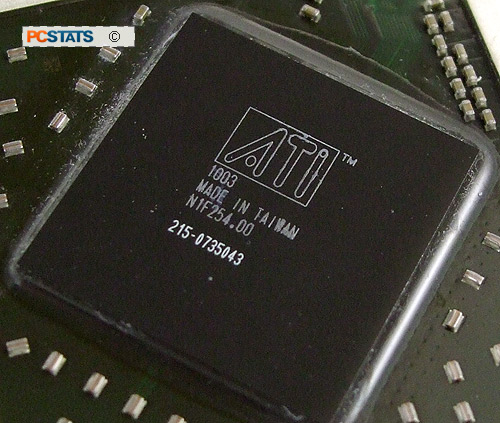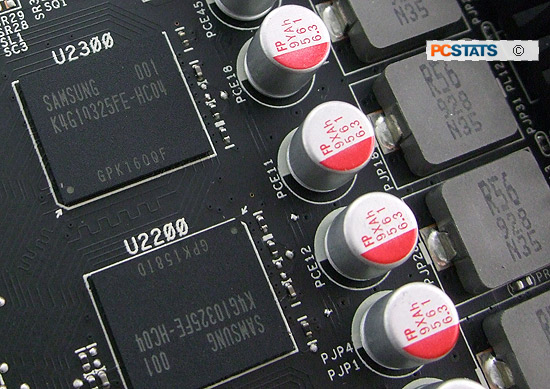All of ATI's Radeon 5000-series videocards draw from a
family of GPUs called 'Evergreen', which is then divided into a smaller GPU
lines based on performance. The fastest line is code named 'Cypress', and this
is the GPU that's the heart of the ASUS' EAH5850 DirectCU TOP videocard PCSTATS is reviewing
for you today.
The RV850 'Cypress' GPU is produced on a 40nm production
process that ATI first introduced in the Radeon 4000-series. Getting down to a
40nm process was important because the Radeon HD 5850 has 2.15 billion
transistors on a 334mm2 die, more than double that of last generation's RV770,
which had 956 million transistors.
|

ATI Radeon HD 5850 'Cypress'
Graphics Processor (GPU) exposed.
|
This wealth of transistors comprise the Radeon HD 5850's
1440 stream processors, 72 texture units, 32 raster operators and the 256-bit
wide memory interface that connects the RV870 GPU to its GDDR5 memory. Stock
Radeon HD 5850 videocards have 1GB of GDDR5 memory clocked at 1000MHz, however
ASUS has factory overclocked the EAH5850 DirectCU TOP so that its 1GB of memory
runs at 1125MHz, which is then GDDR5-quad-pumped up to 4500MHz.
| ATI Radeon / GPU
Comparisons |
|
ATI Radeon 4870 |
ATI Radeon HD
5770 |
ATI Radeon HD 5830 |
ATI Radeon
HD 5850 |
| GPU Code Name: |
RV770 |
RV840/Juniper |
RV870/Cypress |
RV870/Cypress |
| GPU Process: |
55nm |
40nm |
40 |
40nm |
| GPU Transistors: |
956 Million |
1.04
Billion |
2.15 Billion |
2.15 Billion |
| TDP: |
110W |
108W |
175W |
151W |
| GPU Core Clock Speed: |
750MHz |
850Mhz |
800Mhz |
725Mhz |
| Memory Speed: |
900MHz (3600MHz
GDDR5) |
1.2GHz(4.8Ghz
GDDR5) |
1GHz(4GHz GDDR5) |
1GHz(4Ghz GDDR5) |
| Memory Capacity: |
512MB/1GB |
1GB |
1GB
|
1GB
|
| Memory Bus Width: |
256-bit |
128-bit |
256-bit |
256-bit |
| Stream Processors: |
800 |
800 |
1120 |
1440 |
| Texture units: |
40 |
40 |
56 |
72 |
| Raster Operators: |
16 |
16 |
16 |
32 | | |
All of AMD's Radeon 5000-series of graphics cards share a
number of new technologies, the most important of which is support for DirectX
11. This latest revision to Microsoft's graphics hardware standard brings two
major additions to the DX11, tessellation and compute shaders. Tessellation is a
method of adding density and complexity to a 3D mesh. It can take a simple,
low-poly model and break up the geometry into more complex portions, adding
another layer of detail on top of a mesh. The end result is better looking, more
detailed graphics with a very low cost in performance.
|

The videocard has 1GB of GDDR5
Samsung K4G10325FE-HC04 DRAM, running at 1125MHz (default is 1000MHz)
which is quad-pumped to an effective 4GHz clock
speed.
|
Compute shaders allow DirectX 11-based GPUs to do tasks
normally reserved for CPUs. This will play a big role in desktop applications
that harness the power of a PCs videocard, as well as enable games programmers
use the GPU to compute things like physics and AI. Again, this opens up the
possibility for more immersed gaming, but with a miniscule performance penalty
when compared to using a CPU.
Now let's
see just how well ASUS' EAH5850 DirectCU TOP stands up to a little
overclocking... but first, power draw.
